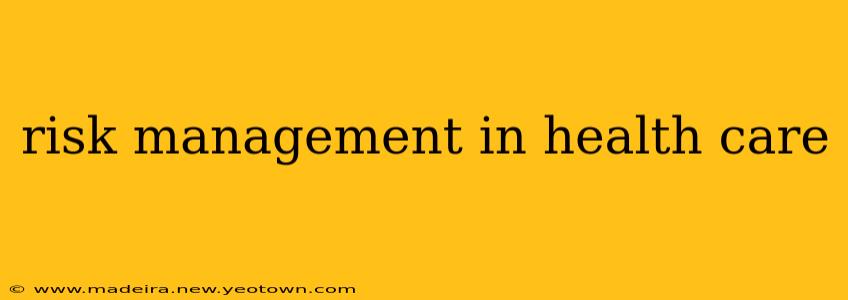The world of healthcare is a complex tapestry woven with threads of life, death, hope, and immense responsibility. Within this intricate design lies a critical element often overlooked until a crisis unfolds: risk management. It's not just about avoiding lawsuits; it's about safeguarding patient well-being, protecting staff, and ensuring the long-term sustainability of healthcare organizations. This journey delves into the heart of healthcare risk management, revealing its multifaceted nature and its crucial role in the modern medical landscape.
Imagine this: a bustling hospital, doctors rushing between patients, nurses diligently attending to their needs, and administrators navigating a sea of regulations and financial constraints. This is the daily reality of healthcare, a field where even the smallest oversight can have significant consequences. Risk management acts as the guiding compass, helping navigate these potential pitfalls and ensure smooth operation.
What is Healthcare Risk Management?
Healthcare risk management is a systematic process designed to identify, analyze, evaluate, treat, and monitor risks that could jeopardize the safety, quality, and financial stability of a healthcare organization. It's not a one-size-fits-all solution but a dynamic strategy that adapts to the ever-evolving landscape of healthcare. It encompasses everything from preventing medical errors to managing cybersecurity threats and ensuring compliance with intricate regulations.
What are the Different Types of Risks in Healthcare?
The spectrum of risks in healthcare is broad, encompassing various domains:
Clinical Risks: These relate directly to patient care, including:
- Medical errors: Misdiagnosis, wrong-site surgery, medication errors – these are significant concerns requiring robust protocols and constant vigilance.
- Infections: Hospital-acquired infections (HAIs) pose a severe threat, demanding stringent hygiene practices and infection control measures.
- Adverse events: Unintended and undesirable outcomes during treatment, necessitating thorough incident reporting and analysis.
Operational Risks: These relate to the day-to-day functioning of the healthcare organization:
- Staffing shortages: Inadequate staffing levels can lead to burnout, errors, and decreased patient safety.
- Equipment malfunction: Failure of medical devices can have dire consequences, requiring regular maintenance and preventative measures.
- Supply chain disruptions: Issues with procuring essential medications or supplies can compromise patient care.
Financial Risks: These pertain to the financial health of the organization:
- Insurance claims: High costs associated with malpractice lawsuits and insurance premiums.
- Regulatory fines: Non-compliance with regulations can result in hefty fines and reputational damage.
- Cybersecurity breaches: Data breaches can lead to substantial financial losses and legal repercussions.
Reputational Risks: These involve the organization's public image and trust:
- Negative publicity: Adverse media coverage or online reviews can significantly impact patient volume and trust.
- Ethical violations: Breaches of patient confidentiality or unethical practices can lead to severe reputational damage.
How to Implement Effective Risk Management Strategies?
Effective risk management in healthcare requires a multi-pronged approach:
- Risk identification: Regularly assess potential risks through risk assessments, incident reports, and staff feedback.
- Risk analysis: Evaluate the likelihood and potential impact of identified risks.
- Risk treatment: Develop strategies to mitigate or eliminate identified risks, such as implementing new protocols, investing in new technology, or providing additional staff training.
- Risk monitoring: Continuously monitor the effectiveness of risk management strategies and make adjustments as needed.
What are the Benefits of a Strong Risk Management Program?
Implementing a robust risk management program yields several advantages:
- Improved patient safety: Minimizes medical errors and adverse events, leading to better patient outcomes.
- Enhanced operational efficiency: Streamlines processes, reduces waste, and improves resource allocation.
- Reduced financial losses: Minimizes the impact of lawsuits, regulatory fines, and cybersecurity breaches.
- Improved reputation: Builds trust with patients, staff, and the wider community.
- Increased compliance: Ensures adherence to regulatory requirements and industry best practices.
What Role Do Technology and Data Play in Healthcare Risk Management?
Technology is transforming healthcare risk management. Data analytics enables organizations to identify trends, predict potential risks, and proactively address vulnerabilities. Electronic health records (EHRs), predictive modeling, and artificial intelligence (AI) play a crucial role in enhancing risk identification, analysis, and mitigation.
How Can Healthcare Professionals Contribute to Effective Risk Management?
Every healthcare professional has a vital role to play in effective risk management. This involves:
- Reporting incidents: Promptly reporting near misses and adverse events to enable proactive interventions.
- Participating in risk assessments: Contributing valuable insights based on their expertise and experience.
- Adhering to protocols: Following established procedures and guidelines diligently.
- Continuous learning: Staying abreast of best practices and new technologies to enhance risk mitigation capabilities.
Healthcare risk management is not a destination but a continuous journey. By embracing a culture of safety, proactively identifying and mitigating risks, and leveraging technology and data, healthcare organizations can create a safer, more efficient, and more sustainable environment for both patients and staff. The investment in robust risk management is an investment in the future of healthcare, a future where safety, quality, and trust reign supreme.

